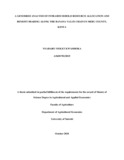A Gendered Analysis Of Intrahousehold Resource Allocation And Benefit Sharing Along The Banana Value Chain In Meru County, Kenya

View/
Date
2018Author
Kwamboka, Nyabaro Violet
Type
ThesisLanguage
enMetadata
Show full item recordAbstract
There has been low inclusiveness of gender dimension in the development of agricultural
policies of Africa despite the fact that women play a crucial part in the African farming structure.
Unequal access to agricultural resources such as land, labor and capital has driven women to less
rewarding roles along the value chain while allowing men to take up the dominant management
roles. This study sought to map the banana value chain with respect to resource allocation and
benefit sharing. Additionally, the study identified the factors that influence gendered resource
allocation in banana production while also looking at the factors determining the participation of
women in benefit sharing. Findings of this study will play a key role in designing agricultural
policies that are aimed at ensuring that the gender gap in African agriculture is less evident. It
could also be used as a guide for development projects geared towards gender equity in
agriculture as it will highlight areas where gender gaps exist between men and women. To
achieve its stated objectives, the study used a fractional logit regression to identify the factors
that influence gender resource allocation and the participation of women in benefit sharing.
Systematic random sampling was used from banana production groups to select the respondents
for the survey. A total of 160 respondents were interviewed. Descriptive statistics from the
survey indicated that men were more concentrated at the production level of the value chain
while women were active participants at the marketing stage. Female education was found to
have a positive effect on land and capital allocation by the wife whereas gender of the household
head negatively impacted on wife land allocation towards the banana enterprise. Other variables
that positively or negatively influenced land and capital allocation were household assets, offfarm
income the current value of livestock, household credit access, extension contact, group
membership among others. Factors that were significant in influencing participation of women in
vi
income use were off-farm income, farm size and years of education of the wife. Given the
importance and significance of livestock in the area, diversification of banana production into
livestock keeping could increase intra-household equity in the sharing of land and capital assets
in the study area. Education of the wife is a factor is linked to human capital, and it is therefore
important for women empowerment. Further research should take a look at the inadequate
participation of the youth in the banana value chain.
Publisher
University of Nairobi
